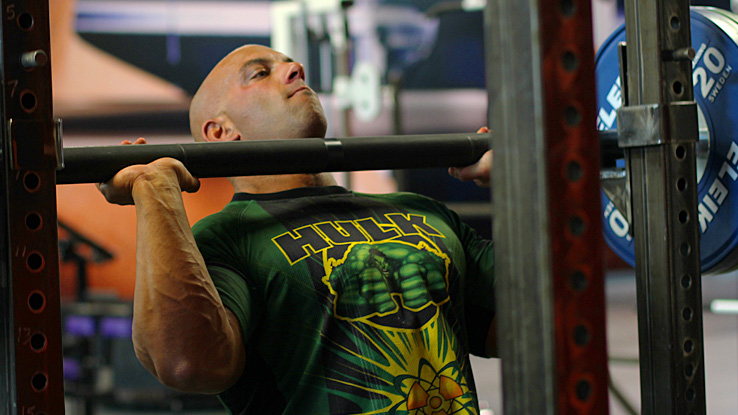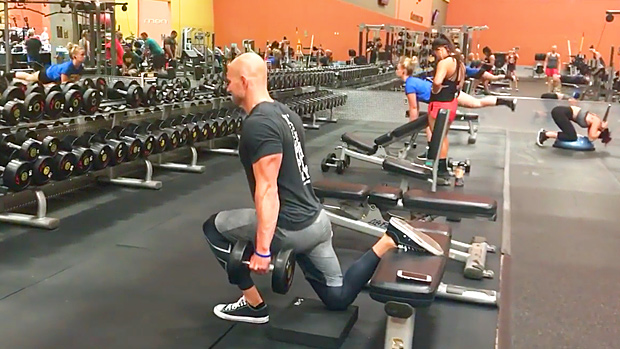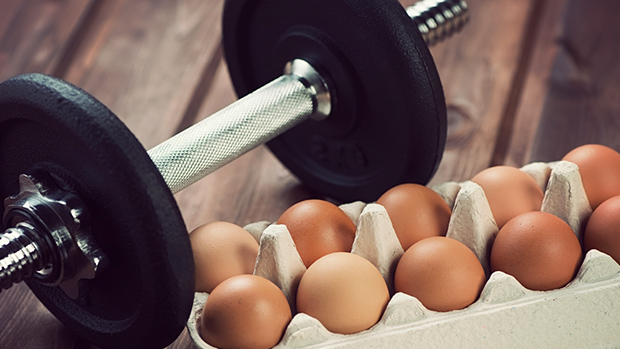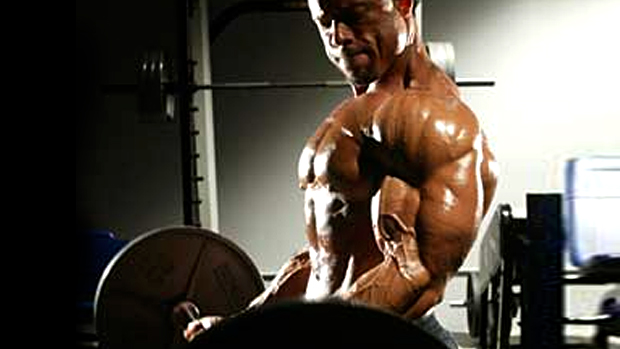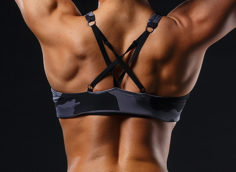The negative/eccentric/lowering portion of a lift offers a serious opportunity to stimulate muscle size and strength gains. However, I typically recommend against emphasizing the eccentric portion of lifts. That's not because eccentric loading isn't effective – properly applied eccentric loading is one of the most important keys to maximizing size and strength – but because lifters doing a lot of volume already get considerable eccentric stress. But what they aren't getting is the right type of eccentric loading. Let me explain.
An important reason to focus on the eccentric is that there's a greater neural adaptation than you see with concentric training (Hortobagyi, et al. 1996). In other words, your nervous system will increase its capacity to recruit motor-units faster as a result of an eccentric overload. Specifically, the nervous system recruits more fast-twitch fibers during an eccentric overload, but fewer total muscle fibers (Nardone, et al. 1989, Howell, et al. 1995, Hortobagyi, et al. 1996).
Since fast-twitch fibers have greater size and strength potential (and since fewer total fibers are being recruited), the fast twitch fibers are under greater stress, resulting in much faster growth. This is also why eccentric loading can easily be overdone – each repetition has a much more profound effect than a regular lifting rep. It's a stronger growth stimulus but can also make you hit the wall faster if not "dosed" properly.
A popular myth is that eccentric loading works primarily by causing more muscle micro-trauma, thereby stimulating more growth. This is also the main reason people misuse eccentric loading. While it's true accentuated eccentric loading causes more muscle micro-tears, this muscle damage is not the main stimulus for growth. Rather, the main cause for muscle growth is cell signaling via several pathways (EPK and PKB pathways for example) as well as the activation of mTOR and the production of local growth factors (IGF-1 for example).
Muscle micro-tears are just a consequence of hard training, but they aren't necessary for growth. In fact, excessive micro-trauma to the muscle fibers might even retard growth. Instead, the greatest benefit of eccentric loading is increasing the recruitment and stimulation of the fast twitch fibers, not in causing more muscle damage. For that reason, the key isn't the volume of eccentric work, but the intensity of that work.
An extended time under tension is an eccentric action. For example, if you do 5 sets of 5 reps and do the eccentric portion in 4 seconds, that's 100 total seconds of eccentric loading volume. Since we're stronger in the eccentric portion of a lift, just slowly lowering a weight that's submaximal for your eccentric strength doesn't overload the muscle – it merely increases the eccentric volume.
And doing a lot of eccentric volume that doesn't constitute an overload (otherwise known as "garbage" eccentrics) increases inflammation, reduces muscle insulin sensitivity, and retards the growth process. The key is to minimize the eccentric volume by not lowering the weight slowly and instead including a small amount of eccentric overload, which is lowering a weight that's close to the maximum you can lower under control. My favorite method is to use weight releasers, but if you have a good training partner, manual accentuated eccentrics can also work.

The greatest benefit of accentuating the eccentric is the increase in fast-twitch motor unit recruitment. The key here is the amount of tension the muscle can produce, which is directly related to the weight on the bar. Most people are about 20-30% stronger during the eccentric portion of a lift, so the weight required to cause an overload during the eccentric requires a lot more than your regular training weight.
For example, a set performed with 90% of your maximum (which is very heavy) only represents about 60-70% of your eccentric maximum. This is still good eccentric stimulation, whereas reps at 60% (during the eccentric) won't do much for gaining mass or strength. And no, going slower will not improve the stimulatory affect of the eccentric. It might stimulate some growth through an occlusion effect, but it won't recruit and stimulate more fast-twitch fibers.
The key is adding more weight to the eccentric portion of the lift while maintaining your regular lowering speed. In other words, you want to lower more weight than you lift. For example if you have 80% of your maximum on the bar, the load during the eccentric portion will be roughly 50-60%. If we add 20-30% on the bar only during the lowering part, we'll thus have a relative load of 80% for both phases.
There are three ways to do this:
- Weight releasers: A device that allows you to hook weight onto the end of the bar. When you lower the weight the device touches the floor, at which point the added weight detaches. This device works best with benches and squats.
- Manual eccentrics: This is the simplest technique but requires a partner. The partner applies pressure on the bar during the eccentric part (thus increasing resistance) and then releases it just before you start the lifting portion. This can work for almost any movement except squats.
- Two-weights set: This is mostly for deadlift variations. Start the bar on J-hooks outside the power rack with 20-30% more weight than you'll lift for your set. Unrack the bar, walk back, and lower the bar to the floor. Remove the added weight and do your set.
- Note: The two-weight set technique also works with bench presses and squats but requires you to use pins. The pins should be set at the lowest point of the lift. Start the bar on J-hooks, unrack the bar with the added weight, lower it to the pins, have a partner remove the added weight, and then do your set.
As mentioned, this is a very powerful method, and like any powerful method people often abuse it! You don't need much of this technique to get all the benefits. And by doing too much you'll actually benefit less. You should only do it for 1 repetition (the first) for 3 work sets of your main exercise in a session. It doesn't have to be the first 3 sets. In fact, it's best if it's not used on consecutive sets.
The only catch is that your first work set of an exercise must use an accentuated eccentric on the first rep to activate the nervous system and prime the fast-twitch fiber recruitment. For example, it might look like this if you're doing 5 sets of 5 reps on your main movement:
- Set 1: 5 reps with accentuated eccentric on rep #1
- Set 2: 5 regular reps
- Set 3: 5 reps with accentuated eccentric on rep #1
- Set 4: 5 regular reps
- Set 5: 5 reps with accentuated eccentric on rep #1
So no more than 3 accentuated eccentric reps per workout.
Don't bother using this method if you're doing "pump" or high rep work. It's best used with methods where fast-twitch fiber recruitment and stimulation is the main goal. The two best times to use it are:
- During max effort work (work in the 88-100% range or 1-5 reps).
- During speed/explosive work (the accentuated eccentric turns on more fast twitch fibers, allowing you to be more explosive).
The goal is to create a state of near maximal effort during the eccentric phase to maximize fast-twitch recruitment. However, a maximal eccentric weight (120-130% of your max concentric) isn't necessary. You'll get full fast-twitch activation with loads of 90-110% of your concentric maximum.
The eccentric load should be:
- Within 90-110% of your concentric max.
- At least 10% higher than the weight you'll lift during the set.
For example, if you plan to do a heavy set with 90% of your max, on the first rep you'd lower with 100% of your max for the eccentric. So if you're lifting 315 pounds (90% of your max), an additional 10% is 31 pounds, which would mean you'd lower 345 pounds on that first rep.
The duration of efficacy of this method is similar to that of depth jumps, which isn't surprising since depth jumps are also based on overloading the eccentric portion of a movement by increasing the shock received upon landing. Both methods will produce rapid results for about three weeks. Going for longer will not deliver any added benefits and may decrease performance.
I recommend using this approach four weeks out of 12 at the most. The best timing would be the last four weeks of a 12 weeks training cycle. After eight weeks on a training cycle, gains are harder to come by, so a method like this can allow you to finish strong and establish a few PRs.
- Accentuated eccentrics work but not for the reason people believe.
- Focus on heavy and controlled, not on moderate weights lowered slowly.
- You need very little accentuated eccentric volume to get the full benefits – 3 total reps per workout is all you need if you use the proper intensity.
- This method works for four weeks, but the benefits from the increase in the capacity to recruit the fast twitch fibers will carry over to your subsequent training programs.

